 |
|
|
|
|
|
|
| ||||||||||
|
|
|
|
|
|
|
||||
| ||||||||||
|
|
|
|
|
Persons using assistive technology might not be able to fully access information in this file. For assistance, please send e-mail to: mmwrq@cdc.gov. Type 508 Accommodation and the title of the report in the subject line of e-mail. Surveillance for Violent Deaths --- National Violent Death Reporting System, 16 States, 2005Please note: An erratum has been published for this article. To view the erratum, please click here. Prepared by
Corresponding author: Debra L. Karch, PhD, Division of Violence Prevention, National Center for Injury Prevention and Control, 4770 Buford Highway, N.E., MS F-63, Atlanta, GA 30341; Telephone: 770-488-1307; Fax: 770-488-1662; E-mail: dwy0@cdc.gov. AbstractProblem/Condition: An estimated 50,000 persons die annually in the United States as a result of violence-related injuries. This report summarizes data from CDC's National Violent Death Reporting System (NVDRS) regarding violent deaths from 16 U.S. states for 2005. Results are reported by sex, age group, race/ethnicity, marital status, location of injury, method of injury, circumstances of injury, and other selected characteristics. Reporting Period Covered: 2005. Description of System: NVDRS collects data regarding violent deaths obtained from death certificates, coroner/medical examiner reports, and law enforcement reports. NVDRS began operation in 2003 with seven states (Alaska, Maryland, Massachusetts, New Jersey, Oregon, South Carolina, and Virginia) participating; six states (Colorado, Georgia, North Carolina, Oklahoma, Rhode Island, and Wisconsin) joined in 2004 and four (California, Kentucky, New Mexico, and Utah) in 2005, for a total of 17 states. This report includes data from 16 states; data from California are not included in this report because NVDRS has been implemented only in a limited number of California cities and counties rather than statewide as in other states. Results: For 2005, a total of 15,495 fatal incidents involving 15,962 violent deaths occurred in the 16 NVDRS states included in this report. The majority (56.1%) of deaths were suicides, followed by homicides and deaths involving legal interventions (29.6%), violent deaths of undetermined intent (13.3%), and unintentional firearm deaths (0.7%). Fatal injury rates varied by sex, race/ethnicity, age group, and method of injury. Rates were substantially higher for males than for females and for American Indians/Alaska Natives (AI/ANs) and blacks than for whites and Hispanics. Rates were highest for persons aged 20--24 years. For method of injury, the three highest rates were reported for firearms, poisonings, and hanging/strangulation/suffocation. Suicides occurred at higher rates among males, AI/ANs, whites, and older persons and most often involved the use of firearms in the home. Suicides were precipitated primarily by mental illness, intimate partner or physical health problems, or a crisis during the previous 2 weeks. Homicides occurred at higher rates among males and young adult blacks and most often involved the use of firearms in the home or on a street/highway. Homicides were precipitated primarily by an argument over something other than money or property or in conjunction with another crime. Similar variation was reported among the other manners of death and special situations or populations highlighted in this report. Interpretation: This report provides the first detailed summary of data concerning violent deaths collected by NVDRS. The results indicate that deaths resulting from self-inflicted or interpersonal violence occur to a varying extent among males and females of every age group and racial/ethnic population. Key factors affecting rates of violent fatal injuries include sex, age group, method of injury, location of injury, and precipitating circumstances (e.g., mental health and substance abuse). Because additional information might be reported subsequently as participating states update their findings, the data provided in this report are preliminary. Public Health Action: Accurate, timely, and comprehensive surveillance data are necessary for the occurrence of violent deaths in the United States to be understood better and ultimately prevented. NVDRS data can be used to track the occurrence of violence-related fatal injuries and assist public health authorities in the development, implementation, and evaluation of programs and policies to reduce and prevent violent deaths and injuries at the national, state, and local levels. The continued development and expansion of NVDRS is essential to CDC's efforts to reduce the personal, familial, and societal costs of violence. Further efforts are needed to increase the number of states using NVDRS, with an ultimate goal of full national representation. IntroductionAn estimated 50,000 persons die annually in the United States as a result of violence-related injuries. Homicide is the second leading cause of death for persons aged 15--24 years, the third leading cause for persons aged 25--34 years, and the fourth for persons aged 1--14 years. Similarly, suicide is the second leading cause of death for persons aged 25--34 years and the third leading cause for persons aged 10--24 years (1). Public health authorities require accurate, timely, and comprehensive surveillance data to better understand and ultimately prevent the occurrence of violent deaths in the United States. The collection of comprehensive risk and prevention data can help prevent violence because violence can be predicted through the analysis of risk and protective factors (2). CDC has collected data concerning school-associated violent deaths that have occurred since 1992 through the School-Associated Violent Death project (3). This project has provided data that are unavailable from either national mortality or law enforcement data sources. These data have helped CDC to monitor school-associated violent deaths and to understand better the associated health burden. CDC also has worked to improve data collection concerning fatalities associated with intimate partner violence, child abuse, and suicide (4,5). In 1999, the Harvard Injury Control Center launched the National Violent Injury Statistics System (NVISS) to support local efforts to gather data concerning violent injuries and to build a model national reporting system (6). Members of the NVISS team worked with the Medical College of Wisconsin, state and local grantees, and others to design and pilot the NVISS reporting system. The model system extracted data from four major reporting sources: death certificates, coroner/medical examiner (CME) records, police reports, supplementary homicide reports (i.e., state and local crime reports submitted voluntarily to the FBI for statistical purposes), and crime laboratory data. In May 2000, the Joyce Foundation and the Harvard School of Public Health jointly sponsored an expert panel meeting to further define the scope, structure, and goals of a new reporting system that would assist in reducing and preventing violent deaths in the United States through the provision of accurate, timely, and comprehensive surveillance data. The goals of this new system would be to
In 2000, CDC started planning for the implementation of the National Violent Death Reporting System (NVDRS) (7). In 2002, Congress appropriated funds for the development of this system. NVDRS was conceived as a state-based active surveillance system that collects risk factor data concerning all violence-related deaths, including homicides, suicides, unintentional deaths caused by firearms, legal intervention deaths (i.e., deaths caused by police and other persons with legal authority to use deadly force), and deaths of undetermined intent. NVDRS data are used to assist the development, implementation, and evaluation of programs and policies designed to reduce and prevent violent deaths and injuries at the national, state, and local levels. Before implementation of NVDRS, single data sources (e.g., death certificates or supplemental homicide reports) provided only limited information and few circumstances from which to understand the etiology of violent death. NVDRS fills this gap in national surveillance; it is the first system to link multiple source documents to enable researchers to understand each violent death better and the first to link multiple violent deaths that are related to one another (e.g., multiple homicides, suicide pacts, and cases of homicide followed by the suicide of the perpetrator) consistently. NVDRS began operation in 2003 with seven states (Alaska, Maryland, Massachusetts, New Jersey, Oregon, South Carolina, and Virginia) participating; six states (Colorado, Georgia, North Carolina, Oklahoma, Rhode Island, and Wisconsin) joined in 2004 and four more (California, Kentucky, New Mexico, and Utah) in 2005, for a total of 17 states (Figure). Funding for state participation is provided by CDC. CDC anticipates that NVDRS will expand to include all 50 states, the District of Columbia, and U.S. territories. This report summarizes data for 2005 regarding violent deaths from 16 states that collected statewide data. Data from California are not included in this report because NVDRS has not been implemented statewide in California as it has in the other 16 states providing data. Because additional information might be reported subsequently as participating states update their findings, the data provided in this report are preliminary. MethodsNVDRS uses multiple, complementary data sources, including death certificates, CME records, and PRs. Secondary sources used by certain participating states include child fatality review team data, supplementary homicide reports, hospital data, crime lab data, and Bureau of Alcohol, Tobacco, Firearms, and Explosives trace information regarding firearms. NVDRS can link together multiple documents for each violent death and also link multiple deaths that are related to each other (e.g., multiple homicides, homicide followed by suicide, or multiple suicides) into a single incident. The ability to analyze data linked in this way allows for a comprehensive assessment of risk and protective factors for violent death. NVDRS defines a violent death as a death resulting from either the intentional use of physical force or power against oneself, another person, or a group or community, or the unintentional use of a firearm. NVDRS case definitions are coded on the basis of the International Classification of Diseases, Tenth Revision (ICD-10) (8). Cases with selected ICD-10 codes are included in NVDRS (Box 1). ICD-10 case finding is completed by participating states. Variables analyzed in NVDRS include the following:
NVDRS is incident-based, and all decedents (both victims and alleged perpetrators [suspects]) associated with a given incident are grouped in one record. Decisions about whether two or more deaths belong to the same incident are made on the basis of the timing of the injuries rather than on that of the deaths. Examples of a violent death incident include 1) a single isolated violent death, 2) two or more related homicides (including legal interventions) when the fatal injuries were inflicted <24 hours apart, 3) two or more related suicides or undetermined manner deaths when the fatal injuries were inflicted <24 hours apart, and 4) a homicide followed by a related suicide when both fatal injuries were inflicted <24 hours apart. Data are obtained from individual information sources and entered into source-specific computerized data entry screens (i.e., police report data are entered into police report screens and death certificate data into death certificate screens). In addition to allowing independent entry for each source, this approach permits later review of what each source contributed and identification of missing sources. This allows for comparisons of the quality and completeness of state-specific data sources and allows states to provide feedback to sources regarding the consistency of their data compared with data from other sources. In addition, the system permits automatic electronic importation of specific data sources without requiring manual entry. Abstraction of identical variables across multiple source documents can result in data inconsistencies. NVDRS resolves these inconsistencies by assigning a primacy, or hierarchical rule, for each variable. The primacy rules are applied to create a final analysis data set that uses data from all available sources. For each variable in NVDRS, primacy is established on the basis of a hierarchy of assumed reliability of all the possible sources for a given variable. For example, sex is collected from three source documents (death certificate, CME record, and police report). The primacy rule for sex is expressed as death certificate/CME record/police report, meaning the analysis file is constructed using the sex recorded in the death certificate; if this is left blank or is unknown, the sex recorded in the CME record is used; and, if the CME record does not provide the sex or lists the sex as unknown, the police report is used. Manner of DeathA manner (i.e., intent) of death for each decedent is assigned by a trained abstractor who takes into account information from all source documents. Typically, these documents are consistent regarding the manner of death, and the abstractor-assigned manner of death corresponds to that reported in all the source documents. On rare occasions, when a discrepancy exists among the source documents, the abstractor must assign a manner of death on the basis of the preponderance of evidence in the source documents. For example, if two sources classify a death as a suicide and a third classifies it as undetermined, the death will be coded as a suicide. NVDRS classifies data using one of five abstractor-assigned manners of death:
Variables AnalyzedNVDRS can analyze approximately 250 unique variables (available at http://www.cdc.gov/ncipc/profiles/nvdrs/default.htm); the number of variables recorded for each incident depends on the content and completeness of the source documents. Variables include manner of death, demographics, ICD-10 and underlying cause-of-deaths codes and text, location and date/time of injury and death, toxicology results, bodily injuries, precipitating circumstances, decedent-suspect relationship, and method of injury (Boxes 2 and 3). Circumstances Preceding DeathThe circumstances preceding death are defined as the precipitating events that led to the infliction of a fatal injury (Box 3). The circumstances that preceded a fatal injury are reported on the basis of the content of CME and police reports. Different sets of circumstances are coded for suicide/undetermined deaths, homicide/legal intervention deaths, and unintentional firearm deaths. The variable "circumstances known" is a gateway variable to a list of potential circumstances. Each incident requires the data abstractor to code all circumstances in cases for which the circumstances are known. If circumstances are not known (e.g., for a body found in the woods with no other detail), the data abstractor leaves the gateway variable blank, and these cases are excluded from the denominator for circumstance values. If either the CME record or the police report indicates that the circumstance is reported to be true, then the abstractor enters data as confirmed (e.g., if the police report indicated that a decedent had disclosed an intent to commit suicide, then suicidal intent is accepted to be true). Coding Training and Quality ControlCoding training is held annually for all participating states. Ongoing coding support is provided through an e-mail help desk, monthly conference calls with all states, and regular conference calls with individual states. A coding manual is provided. Software features enhance coding reliability, including automated validation rules and a hover-over feature containing variable-specific information. Details regarding NVDRS procedures and coding are available at http://www.cdc.gov/ncipc/profiles/nvdrs/publications.htm. States are responsible for performing blind reabstraction of cases using multiple abstractors to identify inconsistencies. CDC also conducts a quality control analysis in which multiple variables are reviewed for the appropriateness with special focus on abstractor assigned variables such as weapon selection and manner of death. If CDC questions any variable, CDC notifies the state and asks for a response or correction. Time FrameStates are required to report all deaths within 6 months of the end of each calendar year for the previous January--December time frame. States then have an additional 12 months to complete each incident record. Although states typically meet these timelines, additional details sometimes arrive after a deadline has passed. New incidents also might be identified after the deadline (i.e., if a death certificate is revised, new evidence is obtained that changes a manner of death, or a miscoded ICD-10 is corrected to meet NVDRS inclusion criteria). These additional data are incorporated into NVDRS. Analysis files are updated monthly at CDC. On the basis of previous experience, CDC estimates that case counts might increase 1%--2% after the first year of data collection. Fatal Violent Injuries During 2005This report provides preliminary data on fatal violent injuries for 2005 for 16 participating states that were received by CDC as of June 30, 2007. Data from California were not included in this report because NVDRS was not implemented statewide, only in a limited number of cities and counties. Participating states used vital statistics death certificate files to identify violent deaths meeting NVDRS case definitions. Each state reported all violent deaths during 2005 that occurred within the state and deaths of state residents that occurred elsewhere. Once a death was identified, NVDRS data abstractors linked source documents, linked violent deaths within each incident, coded data elements, and wrote a short narrative of the incident. These narratives were reviewed for all incidents in which coded data were unclear or incomplete. State-level data then were consolidated and analyzed for this aggregate report. Numbers, percentages, and crude rates are presented in aggregate for all violent deaths by abstractor-assigned manner of death and for special situations and populations (e.g., homicide followed by suicide, suicides of former or current military personnel, and intimate-partner--related homicides). Rates for cells with a frequency of <20 are not reported because of the instability of those rates. In addition, rates could not be calculated for variables such as marital status and precipitating circumstances because denominators were unknown. Bridged-race 2005 population estimates were used as denominators in the rate calculations (9). For compatible numerators for rate calculations to be derived, person records listing multiple races were recoded to a single race when possible, using a bridging algorithm provided by NCHS (available at http://www.cdc.gov/nchs/about/major/dvs/popbridge/popbridge.htm). ResultsAll Violent DeathsViolent Deaths by Sex, Race/Ethnicity, Age Group, and Marital Status The 16 NVDRS states included in this report collected data about 15,495 violent death incidents that occurred during 2005 (Table 1). The crude rate of violent death was 19.9 deaths per 100,000 population; the rate for males was approximately 3.4 times that for females (Table 2). Although the largest number of decedents were white, American Indians/Alaskan Natives (AI/ANs) and blacks had the highest rates of violent death (31.4 and 28.0 per 100,000 population, respectively). Persons aged 20--24 years and those aged 25--54 years had the highest rates of violent death (32.7 and 28.7 per 100,000 population, respectively). Rates of violent death among children aged <1 year and among persons aged >85 years were 24.2 and 19.4 per 100,000 population, respectively. Persons aged 1--14 years had the lowest rates (Table 2). Males aged >15 years in all age groups had rates that were two to seven times higher than rates for females (Table 2). Black and AI/AN males had the highest rate of violent fatal injuries (48.1 and 47.9 per 100,000 population, respectively). Among women, AI/AN females had the highest rate of deaths (15.2 per 100,000 population) (Table 2). Manner, Method, and Location of Injury Suicides accounted for the highest rate of violent death (11.5 per 100,000 population), followed by homicide/legal intervention deaths (6.1 per 100,000 population) (Table 1). Deaths of undetermined intent and unintentional firearm deaths occurred at lower rates (2.7 and 0.1 per 100,000 population, respectively). Of all violent deaths that occurred in 2005 in the 16 states, 48.9% were committed with firearms; poisoning accounted for 18.2% and hanging/strangulation/asphyxiation for 12.2% (rates: 10.0, 3.7, and 2.5 per 100,000 population, respectively); rates for other methods were lower (Table 1). Firearms were used in 55.0% of violent deaths of males (Table 3). The most common methods used in violent deaths of females were poisoning (32.9%) and firearms (29.2%). A residence (house or apartment) was the most common place of injury for both sexes, accounting for 62.0% of deaths of males and 76.3% of those of females (Table 3). The next-most-common location of injury was a street or highway, a motor vehicle, or a parking lot or public garage for males and a street or highway, natural area, or motor vehicle for females. Toxicology Results of Decedent Tests for alcohol were conducted for 76.2% of decedents, and drug tests for amphetamines, antidepressants, cocaine, marijuana, and opiates were conducted for 47.7%, 44.1%, 56.7%, 36.0%, and 54.9% of decedents, respectively (Table 4). Decedents who tested positive for alcohol showed a blood alcohol concentration (BAC) of >0.08 mg/dL (the legal limit in the majority of states) in 59.1% of cases. Opiates, including heroin and prescription pain killers, were identified in 23.8% of cases tested for these substances, antidepressants in 20.2%, cocaine in 15.4%, marijuana in 12.2%, and amphetamines in 5.5%. Seasonality Rates by month showed little variation throughout the year (range: 1.5--1.8 per 100,000 population) (Table 1). SuicidesSex, Race/Ethnicity, Age Group, and Marital Status The 16 NVDRS states included in this report collected data about 8,937 fatal suicide incidents that occurred during 2005 (Table 5). Overall, the crude suicide rate was 11.5 per 100,000 population. The rate for males was nearly four times that for females (18.4 and 4.8 per 100,000 population, respectively) (Table 6). Although whites accounted for the largest number of suicide deaths, AI/ANs and whites had the highest rates of suicide (16.1 and 12.9 per 100,000 population, respectively). The highest rates of suicide by age group occurred among persons aged 75--84 years and those aged 45--54 years (17.0 and 16.9 per 100,000 population, respectively). The rate for those aged >85 years was slightly lower (15.6). Children aged 10--14 years had the lowest rates of suicide among all age groups (1.5 per 100,000 population). Rates of suicide among adolescents aged 15--19 years (7.6 per 100,000 population) were approximately half those for persons aged >19 years. Males aged 35--64 years accounted for approximately 50% of suicide deaths (Table 6). Rates among males were highest for those aged 75--84 years and those aged >85 years (36.7 and 42.1 per 100,000 population, respectively). AI/AN males had the highest rates of any racial/ethnic population, approximately four times rates for Asian/Pacific Islander (API) males. However, both groups accounted for approximately the same percentage of suicide deaths (1.0%--2.0%). Among females, decedents aged 35--64 years accounted for 62.0% of suicides. Rates for females peaked at 8.4 per 100,000 persons aged 45--54 years. As with males, suicide rates were highest among AI/ANs (6.9) and lowest among blacks (1.9) and Hispanics (2.4). Of all decedents, 39.3% were married, 29.5% never married, and 21.9% divorced (Table 6). Method and Location of Injury Firearms were used in the majority (51.5%) of suicide deaths, followed by hanging/strangulation/asphyxiation (19.7%) and poisoning (16.8%) (Table 5). The most common method used by male suicide decedents was a firearm (57.3 %) (Table 7), followed by hanging/strangulation/asphyxiation (19.9%). Among females, poisons were used most often (36.0%), followed closely by firearms (30.3%). Approximately 75% of suicides occurred in a house or apartment, making it the most common place of injury for both males and females (Table 7), followed by natural areas, streets or highways, and motor vehicles (approximately 3%--4% ). A total of 131 (2.1%) suicides occurred in a jail or prison setting (123 males and eight females) (Table 7). Toxicology Results of Decedent and Precipitating Circumstances Tests for alcohol were conducted for 72.1% of suicide decedents, and drug tests for amphetamines, antidepressants, cocaine, marijuana, and opiates were conducted for 41.6%, 40.1%, 48.4%, 35.9%, and 47.7% of suicide decedents, respectively (Table 8). Suicide decedents who tested positive for alcohol showed a BAC of >0.08 mg/dL in 62.1% of cases. Opiates, including heroin and prescription pain killers, were identified in 18.5% of cases tested for these substances; cocaine and marijuana were approximately half as common (7.6%--9.4%) among decedents tested. Of suicide decedents who were tested for antidepressants, 25% were positive at the time of their deaths. Overall, mental health problems were the most commonly noted circumstance for suicide decedents (Table 9), with 45.7% described as experiencing a depressed mood at the time of their deaths. Nearly as many were described as having a diagnosed mental health problem (42.1%), though only 33.0% were under treatment. Approximately 95% of those with a diagnosed mental disorder had received a diagnosis of a mood disorder (e.g., depression/dysthymia or bipolar disorder) or an anxiety disorder (Table 10), 20% had a history of previous suicide attempts, 28.5% disclosed their intent before dying, and 32.3% left a suicide note (Table 9). Other than mental health concerns, circumstances noted most often were intimate partner problems or a crisis of some kind in the previous 2 weeks, each indicated in approximately 30% of suicides. Physical health problems also were recognized in 21.9% of cases. Being a perpetrator of interpersonal violence in the month before death was 5.7% among suicide decedents compared with 0.7% for being a victim of such violence (Table 9). Similar percentages of male and female suicide decedents were observed to have a depressed mood at the time of death; however, nearly twice as many females as males had received a diagnosis of a mental health problem (60.8% and 36.9%, respectively) or were being treated for a mental illness (51.2% and 28.0%, respectively). Approximately the same percentage of male and female suicide decedents experienced physical health problems in the period before their deaths. Intimate partner problems were cited as a precipitating factor in 33% of male suicides and in 26.1% of female suicides (Table 9). Seasonality Rates of suicide by month showed little variation throughout the year (range: 0.8--1.0 per 100,000 population) (Table 5). HomicidesSex, Race/Ethnicity, Age Group, Marital Status The 16 NVDRS states included in this report collected data about 4,483 homicide incidents that occurred during 2005 (Table 11). Overall, the crude homicide rate was 6.1 incidents per 100,000 population in 2005. The majority of homicide decedents never had been married (54.7%), and <25% were married at the time of their deaths (Table 12). The rate for males was approximately 3.7 times that for females (9.6 and 2.6 per 100,000 population, respectively) (Table 13). Blacks accounted for the majority of homicide deaths (50.6%) and had the highest rates (19.4 deaths per 100,000 population), followed by AI/ANs (9.9) and Hispanics (8.2). Age-specific homicide rates were highest (15.9 per 100,000 population) among those aged 20--24 years. The rate for infants aged <1 year was approximately four times that for children aged 1--4 years (8.5 and 2.1 per 100,000 population, respectively) and similar to that for adolescents aged 15--19 years (8.8 per 100,000 population). Rates were lowest among children aged 5--14 years and persons aged >55 years The majority (51.3%) of all male homicide decedents were aged 20--44 years; males in this age group also had the highest homicide rates (Table 13). For females, homicide rates were highest (9.3) among infants aged <1 year. Black males had the highest homicide rate (34.6 per 100,000 population) of any racial/ethnic population. Rates were 5.5 per 100,000 population for black females and 5.1 per 100,000 population for AI/AN females. Method and Location of Injury Firearms were used in 64.5% of homicide deaths (Table 11), followed by sharp instruments (12.2%) and blunt instruments (5.3%). No other single method was used in more than 3.6% of homicides. Firearms were the most common method used in homicides of males (69%) and females (48.4%) (Table 14). Strangulation/suffocation/asphyxiation was nearly seven times more common among female homicide decedents than among males (9.6% and 1.4%, respectively). Females also died more often than males from drowning (0.8% and 0.1%, respectively) and intentional neglect (0.7% and 0.2%, respectively). A house or apartment was the most common place of injury for both males and females, accounting for 42.4% of male deaths and 68% of female deaths (Table 14). The next-most-common location of injury for males was a street or highway (27.5%), parking lot or public garage (4.3%), and motor vehicle (4.1%); for females, the next-most-common locations were a street or highway (8.2%), a natural area (3.4%), or a commercial/retail area (2.3%). Toxicology Results of Decedent and Precipitating Circumstances Tests for alcohol were conducted for 84.3% of homicide decedents, and drug tests for amphetamines, antidepressants, cocaine, marijuana, and opiates were conducted for 49.8%, 41.9%, 65.0%, 35.5%, and 59.1% of homicide decedents, respectively (Table 15). Homicide decedents who tested positive for alcohol showed a BAC of >0.08 mg/dL in 55.6% of cases. Marijuana and cocaine were identified in approximately 21.2% and 17.2% of homicide decedents tested, respectively. Opiates were about half as common; decedents tested for these substances were positive in 7.8% of cases. Only a limited percentage of persons tested for amphetamines, including methamphetamine, tested positive for these drugs. Approximately one third of homicides were precipitated by another crime (Table 16). In 78.6% of these cases, the crime was in progress at the time of the incident. The crime was most often a robbery (39.5%), followed by assault (15.8%), drug trade (10.3%), burglary (9.0%), motor-vehicle theft (3.4%), or rape/sexual assault (3.2%) (Table 17). In those cases that were not precipitated by another crime, the most common precipitating circumstances were an argument, abuse, or conflict over something other than money or property (38.8%); drug-related (17.1%); or an argument regarding money or property (9.5%) (Table 16). In nearly 20% of cases, intimate partner violence was identified as a contributing factor. In <1% of the cases, the decedent was a police officer killed in the line of duty or an intervening person assisting a crime decedent. Arguments, abuse, or conflict unrelated to money or property were factors in more homicides among males than among females (42.8% and 25.9%, respectively). Drug-related homicides accounted for 19.1% of male homicides and 10.6% of female homicides. Intimate partner violence was a precipitating factor in 51.9% of female homicides but only 8.8% of male homicides. In 12.6% of male homicides, the decedent also used a weapon during the altercation, compared with 2.4% of female homicides (Table 16). In 45.5% of homicides, the relation of the suspect to the decedent was not known (Table 12). When a suspect was identified, the suspect most often was an acquaintance or friend (16.6%), a stranger (11.2%), or a spouse or intimate partner (9.9%). Perpetrators were other relatives of the decedent in <15% of cases. Seasonality Rates of homicide by month showed little variation throughout the year (range: 0.4--0.6 per 100,000 population) (Table 11). Deaths of Undetermined IntentSex, Race/Ethnicity, Age Group, Education and Marital Status The 16 NVDRS states included in this report collected data concerning 2,119 violent death incidents during 2005 for which a determination of intent could not be made (Table 18). Overall, the crude rate of undetermined violent deaths was 2.7 per 100,000 population. Rates of undetermined death were higher among males than among females (3.5 and 2.0 per 100,000 population, respectively) (Table 19). Although whites accounted for 76.7% (n = 1,633) of undetermined deaths, rates were highest among AI/ANs and blacks (5.1 and 3.2 per 100,000 population, respectively). The majority of decedents with an undetermined manner of death were aged 35--54 years. Rates were highest among infants aged <1 year (15.3 per 100,000 population) and lowest among persons aged 1--19 years (<0.8 per 100,000 population) and those aged >65 years (<1.7 per 100,000 population). Decedents with an undetermined manner of death most often never were married (37.1%), followed by married (29.0%) or divorced (25.0%) (Table 19). AI/AN males had the highest rates of undetermined death compared with males or females of other racial/ethnic populations (Table 19). Method and Location of Injury In 79.1% of cases of undetermined intent, the method of injury was identified. The most common method was poisoning (64.6%) (Table 18). No other single method was used in >3% of undetermined deaths. Among both males and females for which the method of injury was known, poisoning was used in 62.8% and 68.0% of deaths, respectively (Table 20). The majority of undetermined violent deaths occurred in a house or apartment, making it the most common place of injury for both males and females (68.4% and 79.8%, respectively) (Table 20). A street or highway was the second-most-common setting, accounting for 7.9% of deaths among males and 4.6% among females. No other location type accounted for >4.3% of deaths. Toxicology Results of Decedent and Precipitating Circumstances Tests for alcohol were conducted for 85.3% of decedents of undetermined intent, and drug tests for amphetamines, antidepressants, cocaine, marijuana, and opiates were conducted for approximately 75.8%, 72.6%, 81.2%, 42.0%, and 83.5% of decedents, respectively (Table 21). Decedents whose manner of death could not be determined and who tested positive for alcohol had a BAC of >0.08 mg/dL in 54.3% of cases. Opiates were found in 62.1% of decedents tested for these substances. Of those tested for cocaine, 27.5% tested positive compared with 11.2% of those tested for marijuana. Antidepressants were identified in 30.7% of decedents tested for these substances. Overall, the most commonly noted circumstances for deaths of undetermined intent were substance abuse problems involving a drug other than alcohol (63.1%) or alcohol (26.5%) (Table 22). Although a current depressed mood was reported for only 16.5% of decedents, approximately 40% had a current mental health problem or were in treatment at the time of their deaths (34.0%). Of those with a current mental health problem, approximately 90% of diagnoses were for either mood disorders (e.g., depression/dysthymia or bipolar disorder) or anxiety disorders (77.5% and 13.6%, respectively) (Table 23). The decedent had a history of suicide attempts in 11.7% of cases, disclosed intent to commit suicide in 6.9%, or left a suicide note in 1.3% (Table 22). Other than mental health problems, circumstances noted most often were physical health problems (29.7%), a crisis in the previous 2 weeks (13.8%), or an intimate partner problem (10.6%). A greater percentage of male than female decedents were reported to have an alcohol problem (30.5% and 20.1%, respectively) or other substance abuse problems at the time of death (67.2% and 56.4%, respectively). Mental health problems were reported in a higher percentage of undetermined deaths of females than of males (51.4% and 32.0%, respectively), and a higher percentage of females were currently in treatment for a mental illness than males (44.5% and 27.5%, respectively) and had a history of suicide attempts (17.3% and 8.2%, respectively) (Table 22). Seasonality Rates of undetermined death by month were constant at 0.2 per 100,000 population throughout the year (Table 18). Unintentional Firearm DeathsSex, Race/Ethnicity, Age Group, Education, and Marital Status The 16 NVDRS states included in this report collected data about 112 unintentional firearm deaths during 2005 (Table 24). Males accounted for >90% of decedents; the majority were whites followed by blacks. More than half of unintentional firearm fatalities occurred among persons aged 10--29 years. Males aged 10--29 years accounted for more than half of unintentional firearm deaths. Among females, no age group had more than three cases (data not tabulated because of limited numbers). Approximately 75% of unintentional firearm injury decedents were white males. Location of Injury More than half of all unintentional firearm fatalities took place in a house or apartment, making it the most common place of injury for both males and females, followed by a natural area or forest. All decedents in these areas were male (Table 24). Toxicology Results of Decedent and Precipitating Circumstances Approximately 70% of unintentional firearm decedents were tested for alcohol, and drug tests for amphetamines, antidepressants, cocaine, marijuana, and opiates were conducted for approximately 33%. Decedents who tested positive for alcohol showed a BAC of >0.08 mg/dL in the majority of cases. Marijuana was identified in 25% of decedents tested, and amphetamines, cocaine, and opiates were identified in fewer than five cases (data not tabulated because of limited numbers). Overall, the most commonly noted circumstances for unintentional firearm injury deaths were playing with a gun, hunting, and displaying a gun to others (Table 25). Among those cases for which information was available regarding how the incident occurred (method of injury), pulling the trigger unintentionally was listed most often, followed by dropping the gun. In approximately 20% of cases, the shooter thought the gun was unloaded. The suspect-to-decedent relation was not known or was missing in approximately 75% of unintentional firearm deaths. When a suspect was identified, the suspect was most often an acquaintance or friend of the decedent. Special CircumstancesViolent Deaths with Multiple Decedents The 16 NVDRS states included in this report collected data about 399 violent incidents with more than one fatal injury that occurred during a 24-hour period during 2005 (Table 26). Of a total of 640 victims, 329 (51.4%) were males; 388 (88.6%) of 438 suspects also were males (Table 27). Whites accounted for the highest percentage of decedents (68.1%), followed by blacks (28.1%) and all other racial/ethnic populations at <1%. Hispanics accounted for 13.4% of deaths in multiple fatality incidents. Rates for decedents were highest for persons aged 20--54 years. Suspects most commonly were aged 35--44 years. Firearms were the most common method used (77.2%), followed by sharp instruments (7.8%) and poisonings (3.6%) (Table 26). Homicide Followed by Suicide The 16 NVDRS states included in this report collected data about 200 violent incidents that occurred during 2005 in which a homicide was followed by the suicide of the suspect (Table 28). Of 225 homicide decedents, 168 (74.7%) were female and 180 (90.0%) suspects (suicide decedents) were male. Homicide rates were the same for whites, blacks, and Hispanics (0.3 per 100,000 population); 81.3% of homicide decedents were white. Among suspects who killed themselves after committing homicide, 77.5% were white and 18.0% black. The highest percentages of both homicide and suicide decedents were persons aged 35--44 years (25.3% and 24.0%, respectively). Marital status of homicide decedents and suspects most often were married (not necessarily to each other) (40.6% and 36.4%, respectively) (Table 28). Among decedents tested for alcohol (76.0% of homicide decedents and 75.0% of suicide decedents), positive results indicated that both homicide and suicide decedents most often had BAC <0.08 mg/dL (63.2% and 50.0%, respectively) (Table 29). Suspects who killed themselves following a homicide and who were tested subsequently for drugs tested positive for amphetamines, antidepressants, and marijuana more often than homicide victims. Homicide decedents tested positive for opiates more often than suspects. With respect to location, 75.1% of the homicides occurred in a house or apartment; 5.8% on streets or highways, and 4.5% in a motor vehicle or natural area (Table 29). Firearms were the most common (86.7%) method used in homicides (Table 29). Although 15.2% of persons who committed suicide following a homicide had a diagnosed mental health problem, only 10.0% were receiving mental health treatment at the time of the fatal incident (Table 30). Intimate partner relationship problems preceded homicide followed by suicide in 78.5% of suspect suicides. Other nonintimate partner relationship problems contributed to 10% of suspect suicides. Of suspects who killed themselves, 86.9% had had a personal crisis within the previous 2 weeks. The crisis was related to criminal or civil legal problems in 26.2% of suspect suicides and to physical or financial problems in 18.4% of suspect suicides; 16.8% of suicide decedents had disclosed their intent to kill themselves, and 4.7% had a history of suicide attempts (Table 30). Intimate Partner Homicide The 16 NVDRS states included in this report collected data about 573 incidents of intimate partner homicide that occurred during 2005 (Table 31). Of 594 homicide victims, 386 (65.0%) were female. Although 62.5% of homicide victims were white, rates were highest for AI/ANs and blacks (2.0 and 1.5 per 100,000 population, respectively). Of 607 suspects, 476 (78.4%) were male; 290 (47.8%) were white and 187 (30.8%) black. The highest percent of victims and suspects were persons aged 35--44 years. The majority (43%) of victims were married. Of decedents tested for alcohol, 61.0% had a BAC >0.08 mg/dL. Although the numbers are small and thus difficult to interpret, cocaine was the most common drug identified in those who were tested for drugs (14.7%) (Table 31). Suicide of Former or Current Military Personnel The 16 NVDRS states included in this report collected data about 1,821 suicides by former or current military personnel that occurred during 2005, comprising 20% of all suicides (Table 32). Of these 1,821 suicide decedents, 1,765 (96.9%) were male, and 1,695 (93.1%) were white. The greatest percent of decedents were persons aged >45 years. The most common method used (67.9%) was firearms, followed by poisoning and hanging/strangulation/suffocation (12.7% and 11.5%, respectively). Of all former or current military personnel decedents who were tested for alcohol, 63.4% had a BAC >0.08 mg/dL. Although 47.2% were depressed at the time of death, and 34.8% had a diagnosed mental health problem, only 26.7% were receiving mental health care (Table 33). With respect to substance abuse, 17.2% had an alcohol problem, and 7.7% had a problem with other substances. With respect to other issues; 24.5% had a problem with an intimate partner; 38.4% had a physical health problem, 28.0% had experienced an acute crisis during the previous 2 weeks; 8.5%--11.8% had either job, financial, or criminal legal problems; 33.9% had left a suicide note; 13.3% had made a previous suicide attempt; and 29.0% had disclosed their intent to commit suicide with enough time for someone to have intervened. Legal Intervention The 16 NVDRS states included in this report collected data on 171 deaths involving fatal injuries attributed to legal intervention that occurred during 2005 (Table 34). Of the 171 decedents, 163 (95.3%) were male. Whites accounted for 62.0% of deaths and blacks for 33.3%. Rates of legal intervention deaths were 0.5 per 100,000 population for blacks and 0.2 per 100,000 for whites. Numbers for other racial/ethnic populations were too small to produce a stable estimate. The highest percent of decedents were persons aged 20--54 years (Table 35). Of all legal intervention decedents who were tested for alcohol (83.0 %), 63.2% of those that were positive had a BAC of >0.08 (Table 34). The presence of other drugs for which positive tests were found varied: 21.8% of decedents tested positive for marijuana, 15.5% for amphetamines, 14.4% for cocaine, 10.7% for antidepressants, and 5.8% for opiates. With respect to location, 37.4% of legal intervention deaths occurred in a house or apartment, 28% on a street or highway, and 2.9% occurred in a jail or prison. Infant/Child Deaths The 16 NVDRS states included in this report collected data concerning 546 incidents that occurred during 2005 involving 557 decedents aged <14 years (Table 36). Of these 557 decedents, 347 (62.3%) were male and 335 (60.1%) were white. Rates were higher for males than for females (4.3 and 2.7 per 100,000 population, respectively). AI/ANs and blacks had the highest rates among racial/ethnic populations (9.9 and 5.9 per 100,000 population, respectively). By age group, the highest rates (24.2 per 100,000 population) occurred among infants aged <1 year and the lowest (0.7 per 100,000 population) among children aged 5--9 years. The greatest percentage of cases in which the method was known involved a firearm (18.0%), followed by hanging/strangulation/suffocation (15.6%) and personal weapons (i.e., hands, fists, or feet) (8.1%) (Table 37). For 156 (28.0%) deaths, the method was unknown. A suspect was not identified for 338 (60.7%) deaths. Of the deaths for which a suspect was known, nearly 20.0% involved a parent or substitute (e.g., step parent, foster parent, or mother's boyfriend) and nearly10% a friend or acquaintance of the child. For both males and females, the highest death rates (males: 26.4 and 21.8 per 100,000 population, respectively) occurred among infants aged <1 year (Table 38). Among males, the highest rates occurred among AI/ANs, blacks, and Hispanics (13.9, 7.0, and 4.4 per 100,000 population, respectively). Among females, the highest rates also occurred among AI/ANs, blacks, and Hispanics (5.8, 4.8, and 2.7 per 100,000 population, respectively). DiscussionDemographic Characteristics and Injury MechanismThe findings in this report indicate clear demographic variations in risk of death from violence-related injuries in 2005. The results indicate that the highest rates of violent deaths occurred among males, AI/ANs, blacks, and younger adults aged 20--29 years. Patterns varied by type of death: suicide rates were higher among whites than among blacks and higher among persons aged >75 years and those aged 45--54 years, whereas homicide rates were highest among adults aged 20--24 years, especially males. For both males and females, rates of homicide were highest among blacks and AI/ANs. Firearms were the most common method used in homicides, suicides, and incidents involving multiple victims. The majority of injury deaths with an undetermined intent were poisonings or had an unknown cause. Information concerning demographic characteristics and injury mechanisms is available from existing data sources such as CDC's Web-based Injury Statistics Query and Reporting System (WISQARS) and the National Vital Statistics System (NVSS) (1,10), and the demographic patterns noted above are consistent with those documented in other reports (11--13). Data regarding location of injury, decedent toxicology, and precipitating circumstances of violent deaths are unique to NVDRS. For example, NVDRS data indicate that the home was the most common location of violent death for all manners of death. Intoxication also was widespread among decedents, and more than half of decedents who tested positive for alcohol were above the state-specific legal limit for intoxication at the time of death. Within each manner of death, NVDRS data provide important insights into key circumstances. Current mental health and/or substance abuse problems, relationship problems and losses, and recent crises were frequent precipitants for suicide. These factors have been documented as important risk factors for suicide in other studies (12,14). Despite the high prevalence of mental health problems among suicide decedents, only one third were known to be receiving treatment at the time of death. Whether the lack of treatment is related to limited access to care or an unwillingness or inability to seek care is unknown. Persons might be unwilling to seek care because of the stigma attached to mental health problems or severe mental illness. Barriers in accessing mental health treatment and stigma are both contributing factors in cases of suicide (12,14). Typically, homicide decedents were males killed as the result of an argument or conflict or during the commission of a crime (predominately a robbery). The majority of homicides were committed with a firearm. Only 20% of male homicides and 10% of female homicides were known to be related to illegal drugs. Research concerning youth homicide indicates that interpersonal disputes can turn deadly, especially when lethal means, such as firearms, are involved in the dispute (15,16). Even though homicides involving the use of firearms have decreased substantially since the mid-1990s, the proportion of homicides among persons aged 15--24 years that are committed with a firearm has remained high (approximately 80%) and relatively stable over time (1). In contrast to male homicides, the most common precipitating factor in female homicides was intimate partner violence. In the United States, approximately one third of all female murder decedents are killed by a current intimate partner (17) and an additional 10%--20% by an ex-partner (18). NVDRS CapabilitiesA key feature of NVDRS is its ability to identify incidents involving multiple decedents and incidents in which the perpetrator has a specific relationship to the decedent. Multiple decedent homicides and homicide-suicide incidents account for <3% of violent death incidents but have a substantial impact on the decedents' families and communities. The findings provided in this report indicate the existence of differences by gender. Although the proportion of decedents in incidents involving multiple violent deaths was divided equally between males and females, approximately 90% of the suspects in these incidents were male. In incidents when a homicide was followed by a suicide, a similar proportion of the perpetrators were males, but 75% of the decedents were female. In the majority of these incidents, problems with a romantic partner were cited as an important precipitating factor, as were crises occurring within the 2 weeks previous to the suicide. In intimate partner homicide incidents that were not followed by suicide, the majority of the decedents were females, and >75% of the suspects were males. These findings underscore the importance of enhancing ongoing efforts to address partner violence, situational stressors, and suicidal ideation to reduce risk for certain types of homicides, particularly incidents involving male perpetrators and female decedents. In addition to enabling researchers to examine multiple decedent incidents, NVDRS permits examination of violent deaths involving specific populations. For example, NVDRS data indicate that the majority of decedents of suicide among former or current military personnel were white males who were married at the time of death and who used a firearm to commit suicide. Precipitating circumstances associated with suicide among former or current military personnel were similar to those among all male suicide decedents, with one exception. The proportion of former or current military personnel reported to be experiencing health problems was nearly double that for persons who were not former or current military personnel. This might reflect a difference in reporting and contact with health professionals related to their former or current military status. In >40% of suicides, physical illness is considered a contributory factor, especially if mood disorders or depressive symptoms also are present (19). Prevention OpportunitiesThese findings suggest that prevention opportunities exist to reduce violent deaths in ways that are common across types of violence. Risk and protective factors for violence operate at multiple levels of social influence (19). Prevention programs therefore can benefit from considering how best to address individual-level factors while taking into account the factors within families, peer groups, schools, or communities that contribute to violent behavior. Information concerning the precipitating circumstances in this report provides some important clues in terms of where to focus prevention efforts. For example, substance abuse (especially alcohol) affected substantial proportions of both homicide and suicide decedents. Efforts aimed at reducing substance abuse, such as education and community-based approaches and laws and policies to prevent alcohol-related problems, have the potential to reduce several types of violent death (20). The results also highlight the importance of prevention programs and policies that increase the accessibility of treatment for mental health and substance abuse problems. Relationship problems, interpersonal conflicts, and recent crises were also important precipitating factors. Programs designed to enhance social problem-solving and coping skills to deal with stressful life events and problems that surface within interpersonal relationships can also potentially reduce violence (21). Addressing the social and economic conditions within communities that often give rise to violence also is important. In general, prevention approaches that address multiple domains of influence on behavior are more likely to have a preventive impact than those that focus on a single risk factor (22). LimitationsThe findings provided in this report are subject to at least six limitations. First, the availability, completeness, and timeliness of data are dependent on the sharing of data among state health department NVDRS teams, coroner/medical examiners, and law enforcement personnel in their states. This is particularly challenging when states have independent county coroner systems rather than a centralized medical examiner system. NVDRS incident data might be limited or incomplete for areas in which these data-sharing relationships are not fully developed. Second, abstractors are limited to the data included in the reports they receive. Reports might not fully reflect all information known about an incident, particularly in the case of homicides, when data are less readily available until after prosecutions are complete. Third, case definitions present challenges when a single death is classified differently in different documents (e.g., "unintentional" in a police report, "homicide" in a coroner/medical examiner report, and "undetermined" on the death certificate. NVDRS abstractors reconcile these cases using standardized NVDRS case definitions and select a single manner of death on the basis of all source documents. Fourth, NVDRS data are available only from a limited number of states and therefore are not nationally representative. Finally, although extensive coding training is conducted and help desk support is available daily, variations in coding might occur depending on the abstractor's level of experience. For this reason, states regularly conduct blinded reabstraction of cases to test consistency and identify training needs. Finally, protective factor data are not collected by NVDRS as a result of the nature of death certificate, CME, and police reports, which typically contain only circumstances associated with risk factors. ConclusionMore effective prevention programs are needed to prevent violent deaths in the United States. Accurate, timely, and comprehensive surveillance data are necessary for violent deaths in the United States to be better understood and ultimately prevented. NVDRS data can be used to track the occurrence of violence-related fatal injuries and assist public health authorities in the development, implementation, and evaluation of programs and policies that reduce and prevent violent deaths and injuries at the national, state, and local levels. Continued development and expansion of NVDRS is critical to CDC's ongoing efforts to reduce the personal, familial, and societal costs of violence. Further efforts are needed to increase the number of states using NVDRS, with an ultimate goal of full national representation, including all 50 states, the District of Columbia, and U.S. territories. Acknowledgments Contributors to this report included the participating state Violent Death Reporting Systems; participating state agencies, including state health departments, vital registrars' offices, coroners' and medical examiners' offices, crime laboratories, local and state law enforcement agencies; partner organizations, including the State and Territorial Injury Prevention Directors' Association, National Association of Medical Examiners, National Association for Public Health Statistics and Information Systems, Council of State and Territorial Epidemiologists, and Association of State and Territorial Health Officials; federal agencies, including the Department of Justice (Bureau of Justice Statistics and the Federal Bureau of Investigation), the Department of the Treasury (Bureau of Alcohol, Tobacco, and Firearms); the International Association of Chiefs of Police; other stakeholders, researchers, and foundations, including Harvard University School of Public Health, the Joyce Foundation, and Fenton Communications; National Institute for Occupational Safety and Health, National Center for Health Statistics, CDC. References
National Violent Death Reporting System State CoordinatorsMembership List as of November 1, 2007.Deborah Choromanski Hull-Hilly, MPH, Scott Saxton, Alaska Department of Health and Social Services, Anchorage, Alaska; Roger Trent, PhD, Jason Van Court, California Department of Health Services, Sacramento, California; Holly Hedegaard, MD, Colorado Department of Pubic Health and Environment, Denver, Colorado; Laura J. Fehrs, MD, Georgia Department of Human Resources, Atlanta, Georgia; Sabrina Walsh, MPH, University of Kentucky, Lexington, Kentucky; Tracey Serpi, PhD, Ryan Shields, Maryland Department of Health and Mental Hygiene, Baltimore, Maryland; Victoria Ozonoff, PhD, Melissa Trzepacz, Massachusetts Department of Public Health, Boston, Massachusetts; Katherine Hempstead, PhD, Deborah Crabtree, New Jersey Department of Health and Senior Services, Trenton, New Jersey; Barbara Chatterjee, MS, New Mexico Department of Health, Sante Fe, New Mexico; Sharon Rhynne, Tammy Norwood, North Carolina Department of Health and Human Services, Raleigh, North Carolina; Pam Archer, MPH, Sheryll Brown, MPH, Oklahoma State Department of Health, Oklahoma City, Oklahoma; Melvin Kohn, PhD, Lisa Millet, MSH, Oregon Department of Health, Portland, Oregon; Thomas Gilson, MD, Wendy Verhoek-Oftedahl, PhD, Rhode Island Department of Health, Providence, Rhode Island; Lavell Thornton, MPH, Keisha Adams, MPH, South Carolina Department of Health, Columbia, South Carolina; Virginia Powell, PhD, Marc Leslie, MS, Virginia Department of Health, Richmond, Virginia; Patrica Keller, MPH, Utah Department of Health, Salt Lake City, Utah; Linda Hale, Debi Peters, Wisconsin Department of Health and Human Services, Madison, Wisconsin.
Table 1 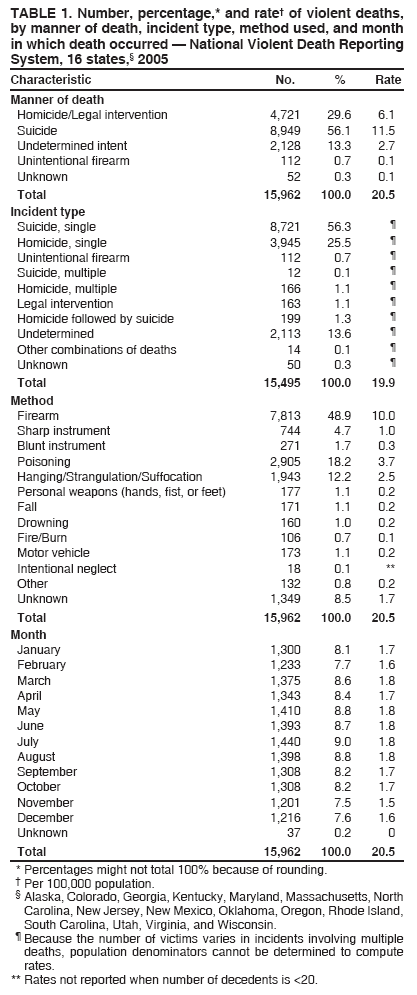 Return to top. Box 1  Return to top. Table 2 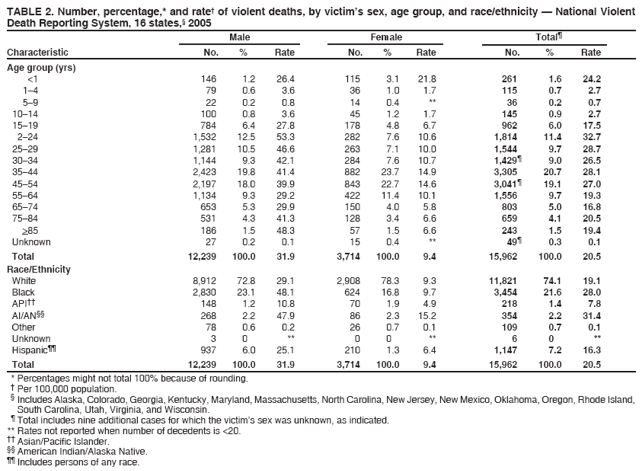 Return to top. Box 2 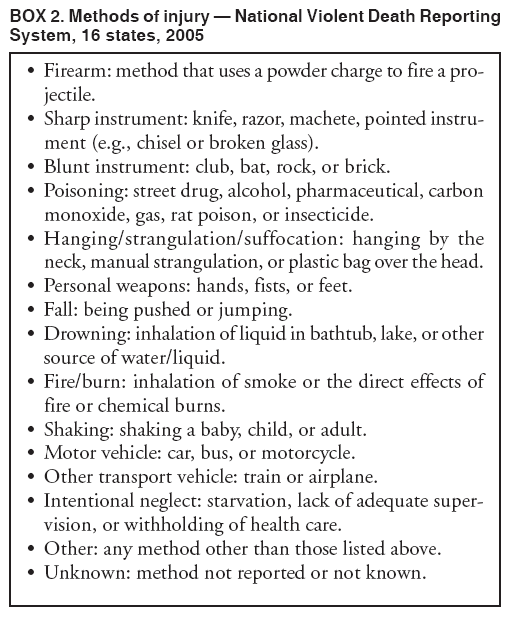 Return to top. Table 3 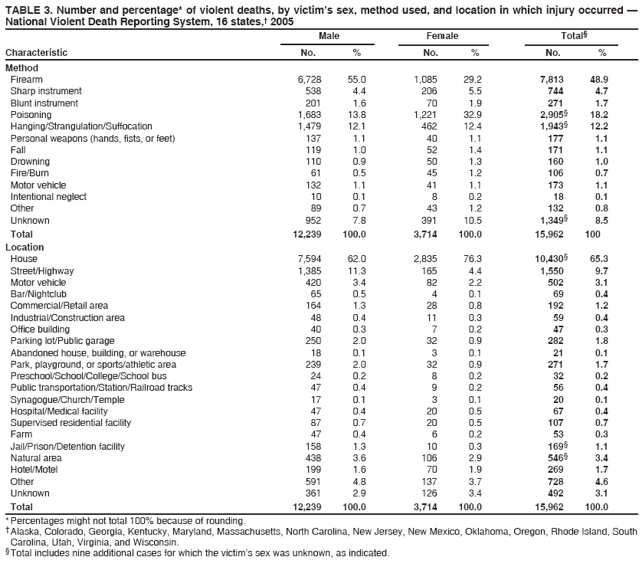 Return to top. Box 3 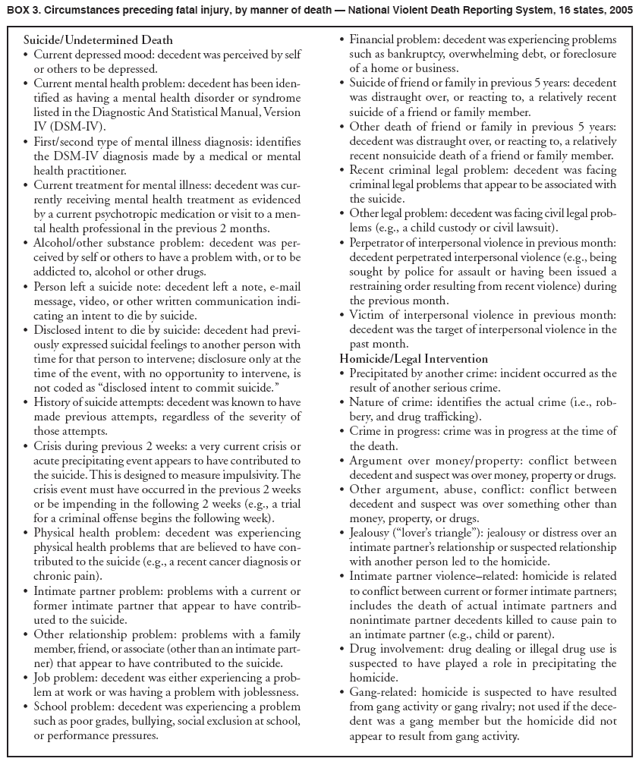 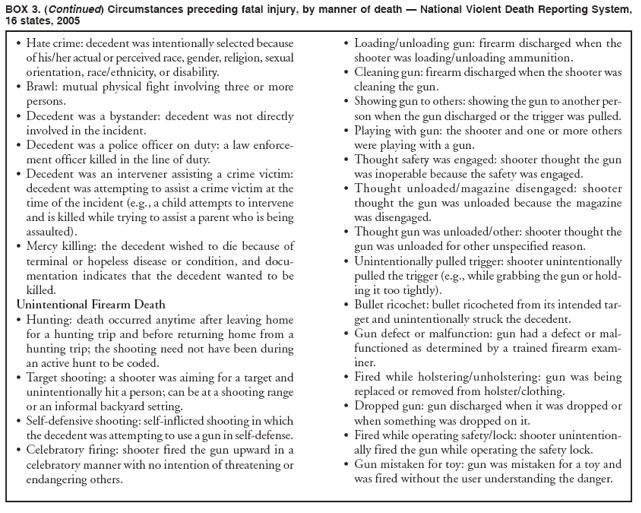 Return to top. Table 4 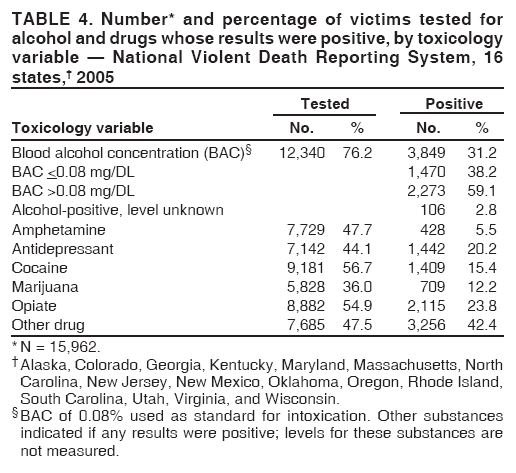 Return to top. Table 5 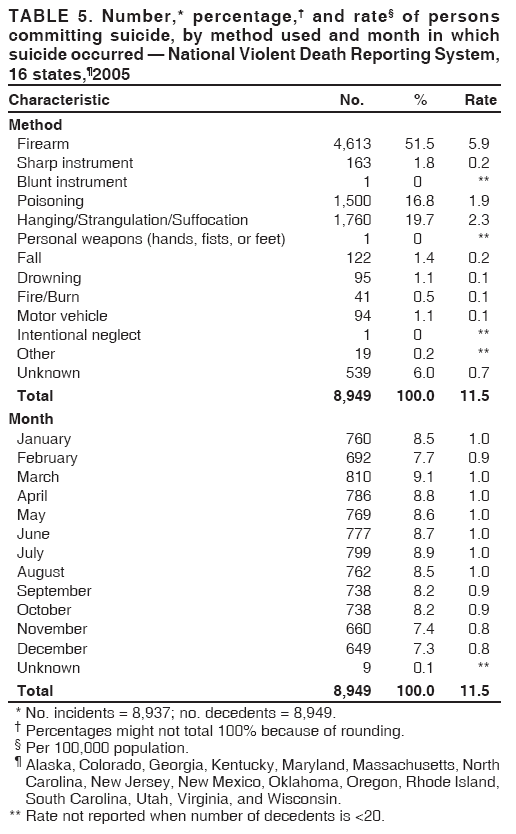 Return to top. Table 6 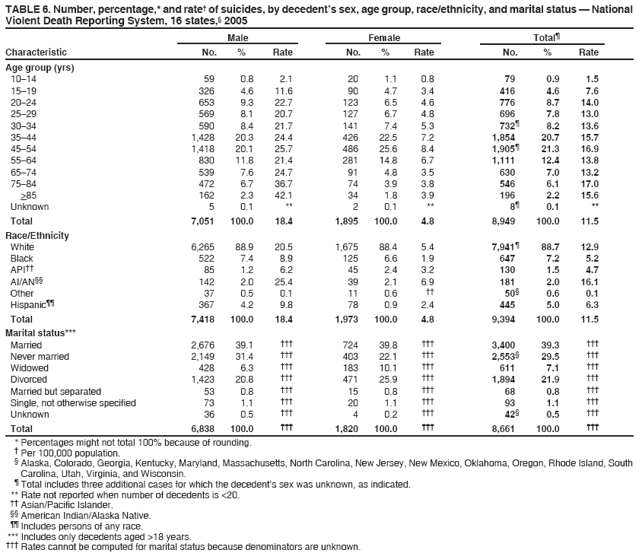 Return to top. Table 7 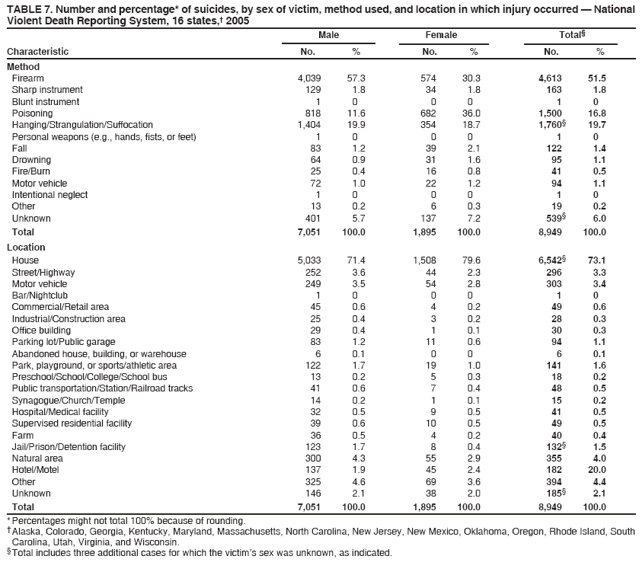 Return to top. Table 8 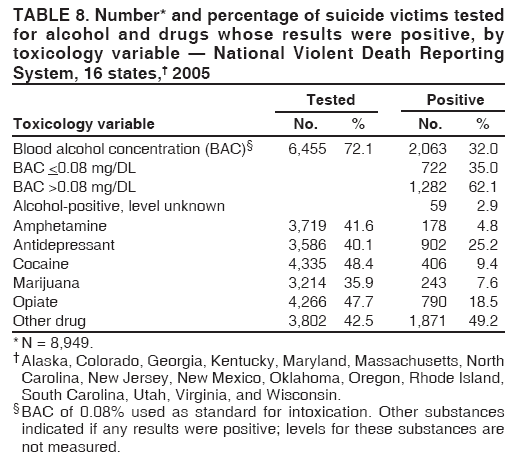 Return to top. Table 9 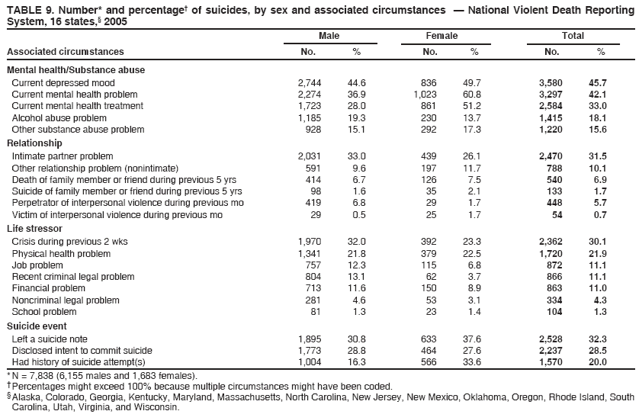 Return to top. Table 10 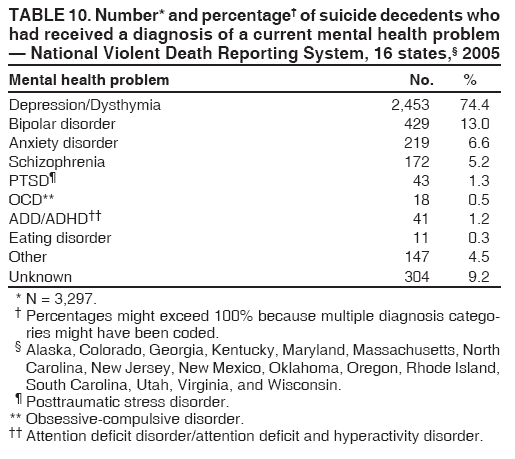 Return to top. Table 11 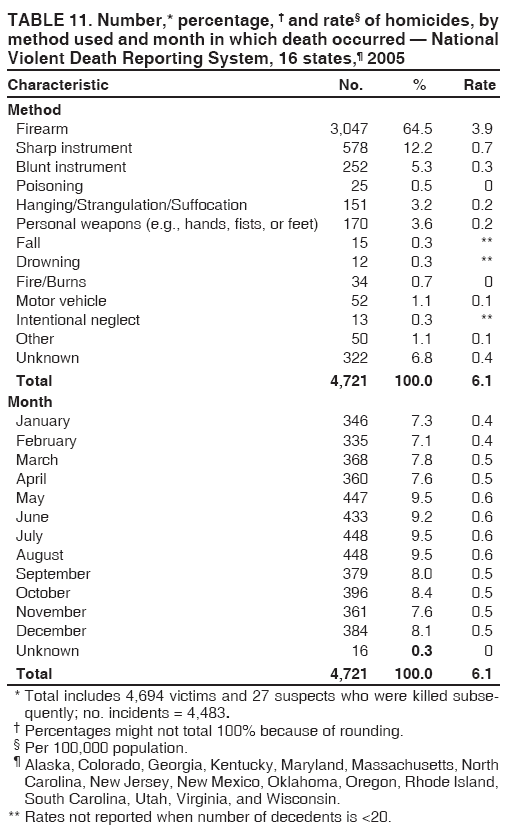 Return to top. Table 12 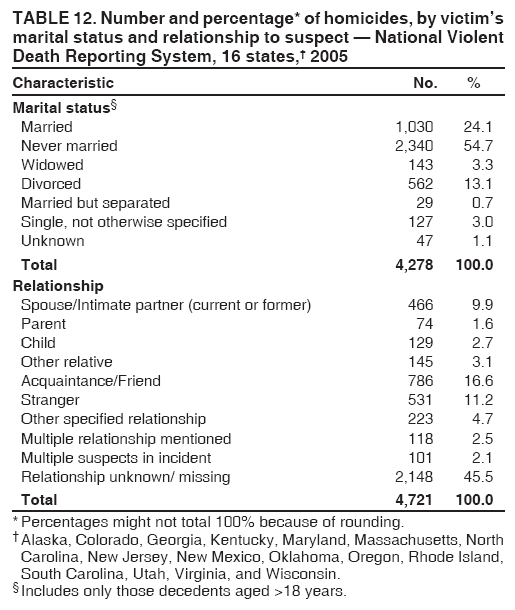 Return to top. Table 13 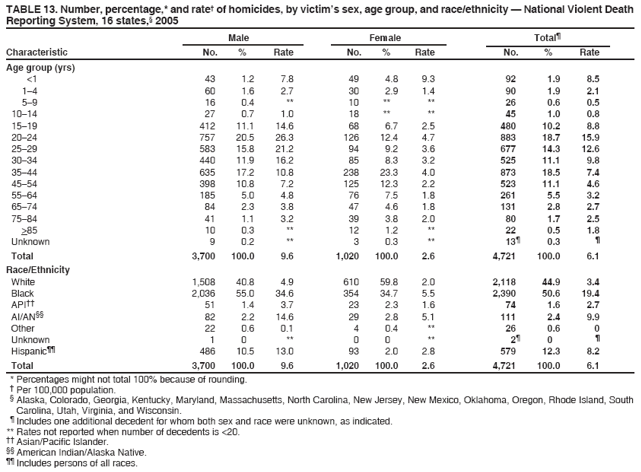 Return to top. Table 14 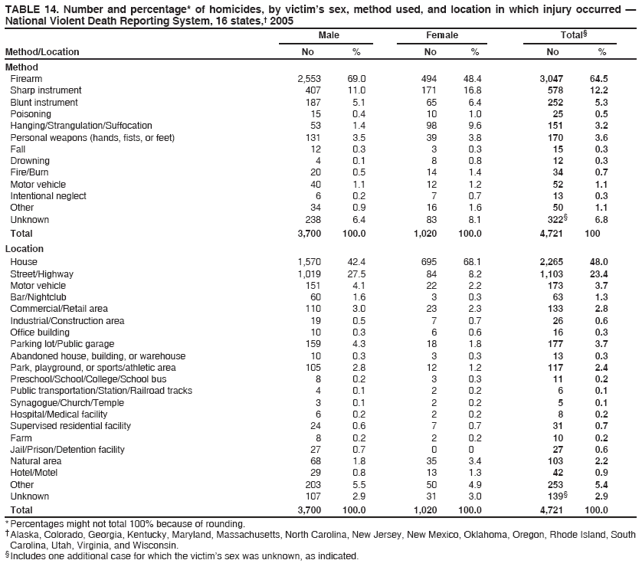 Return to top. Table 15 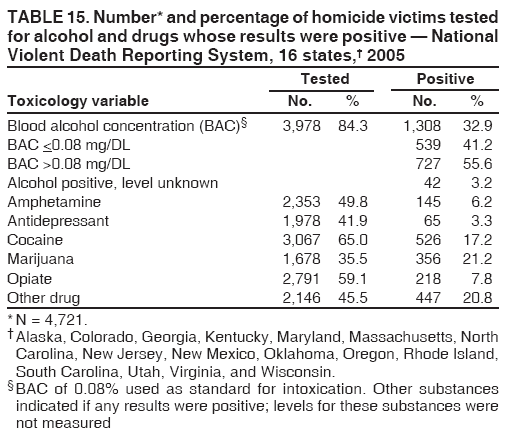 Return to top. Table 16 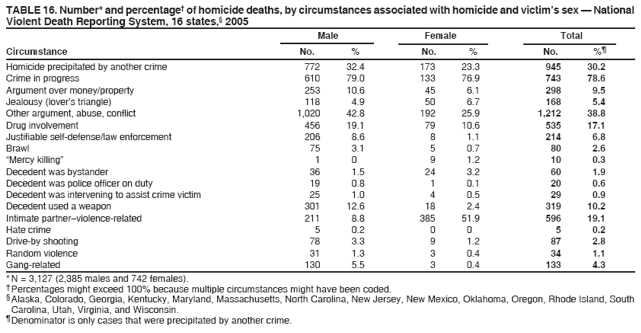 Return to top. Table 17 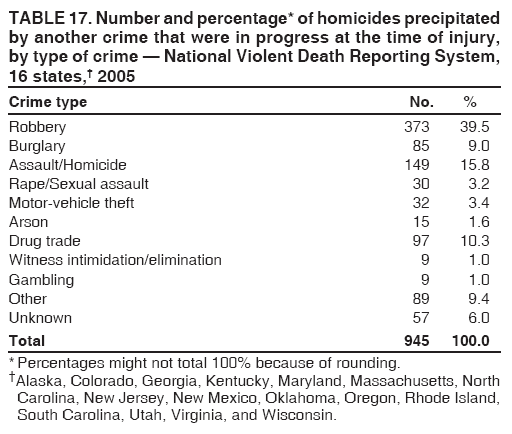 Return to top. Table 18 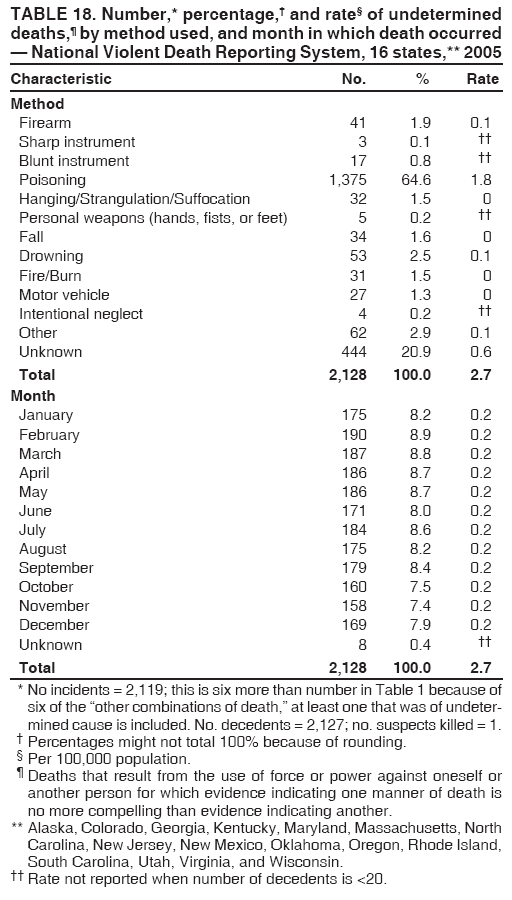 Return to top. Table 19 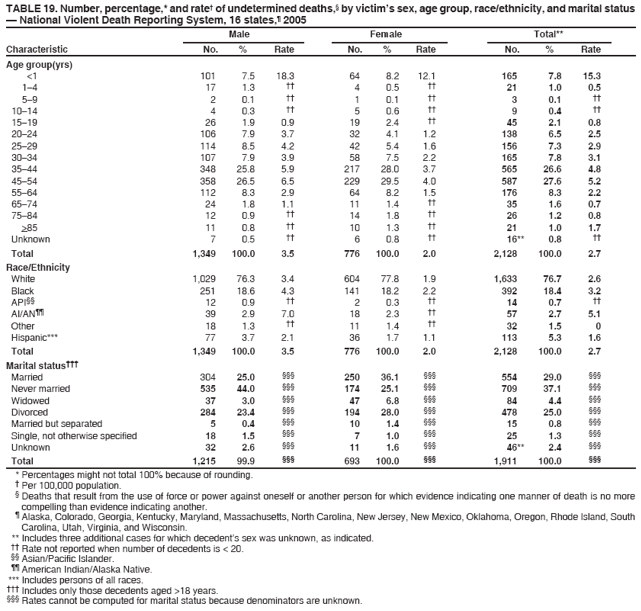 Return to top. Table 20 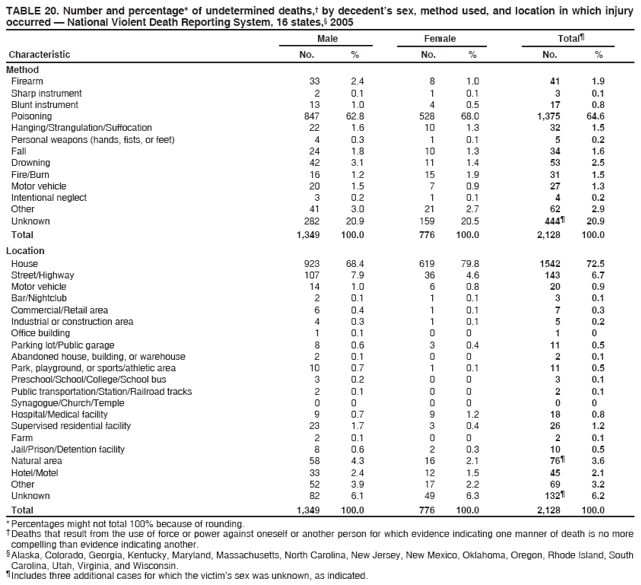 Return to top. Table 21 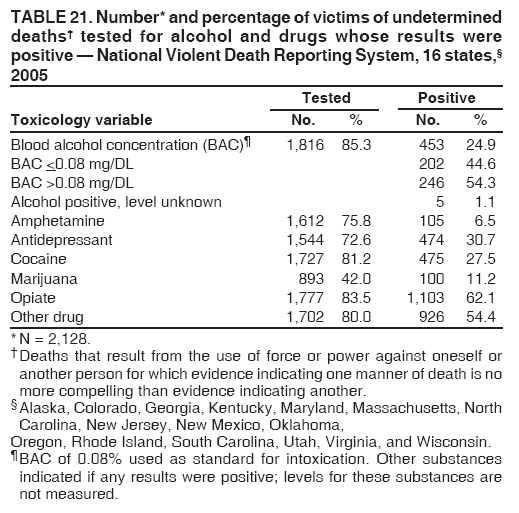 Return to top. Table 22 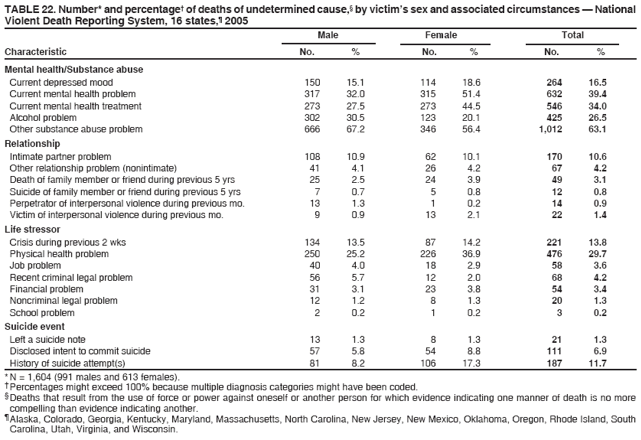 Return to top. Table 23 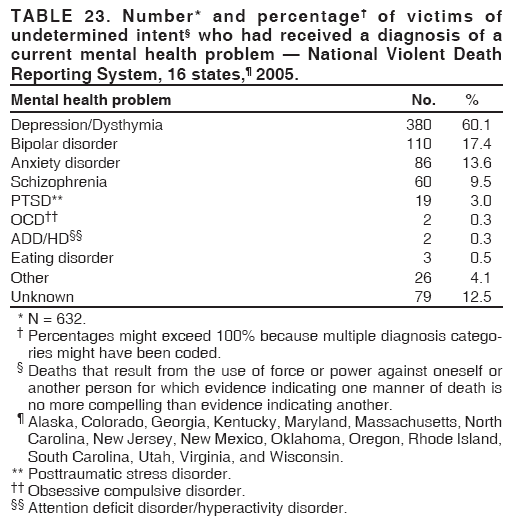 Return to top. Table 24 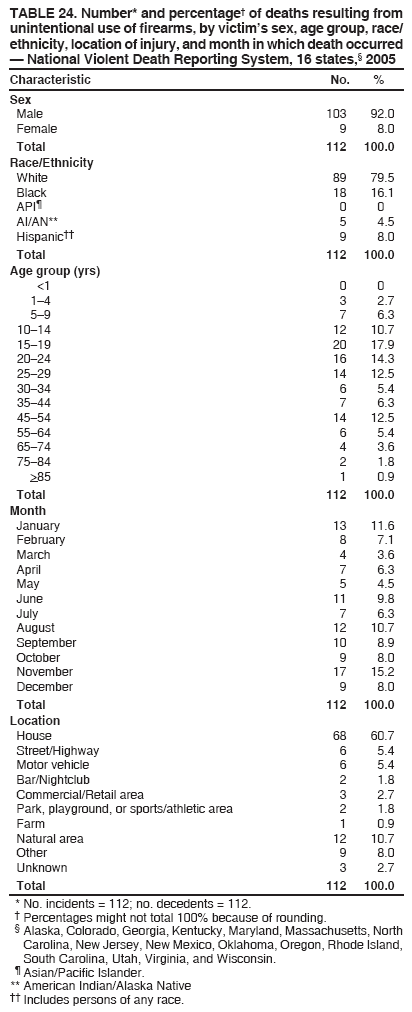 Return to top. Table 25 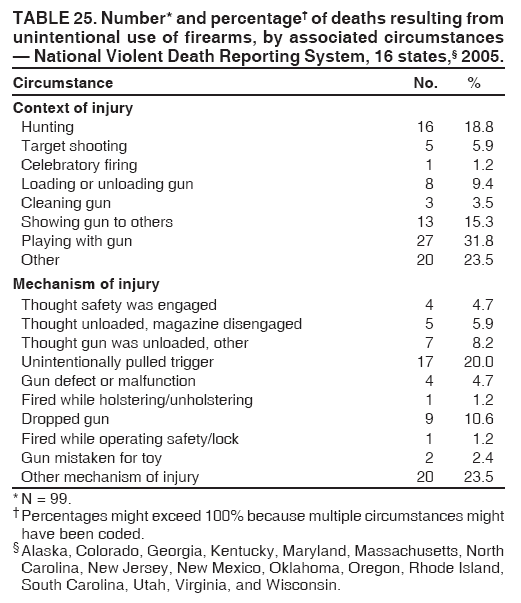 Return to top. Table 26 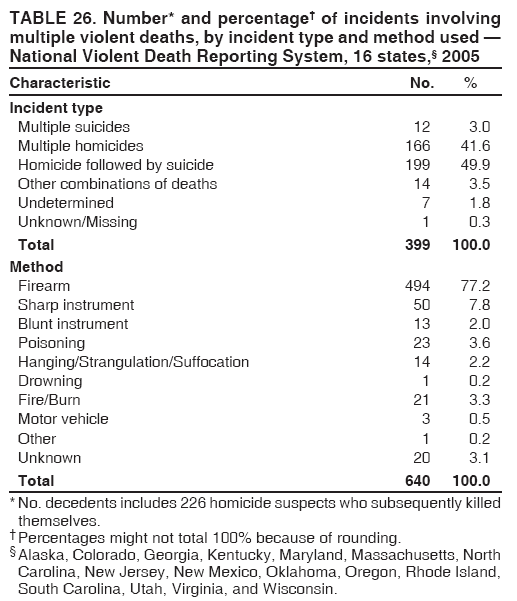 Return to top. Table 27 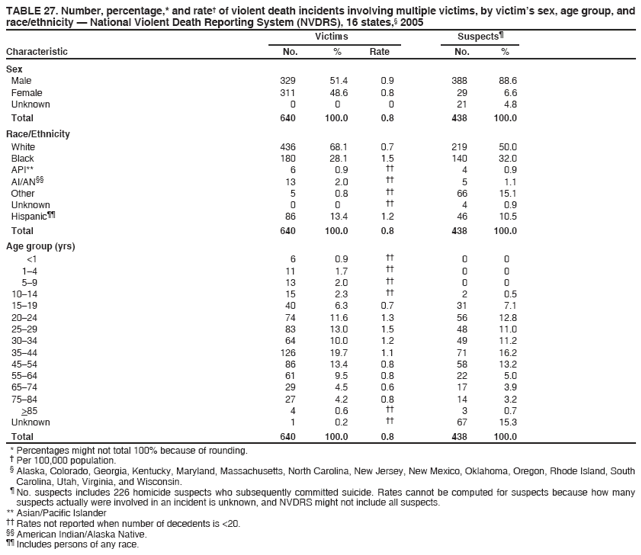 Return to top. Table 28 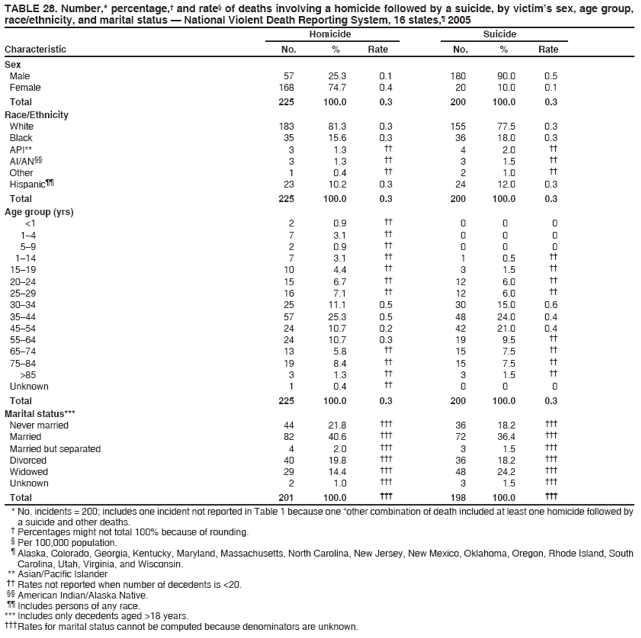 Return to top. Table 29 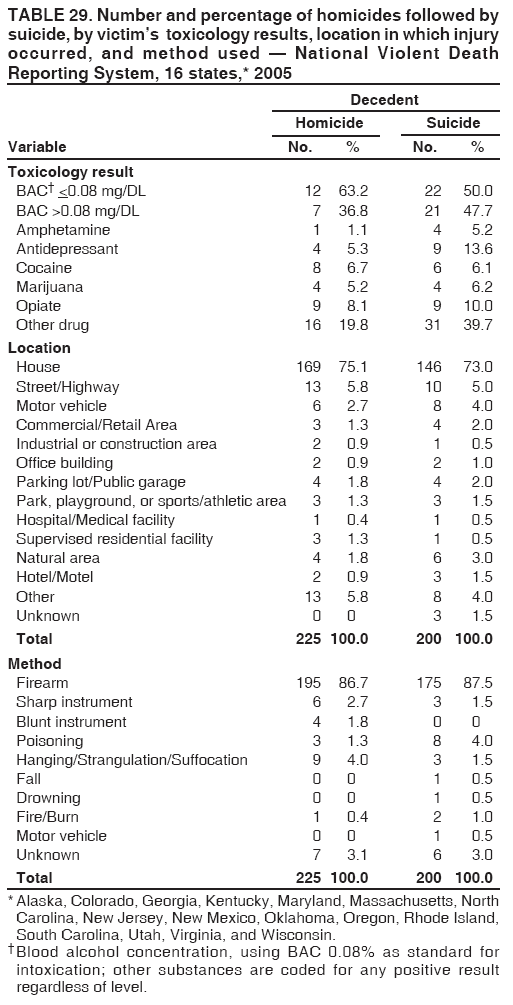 Return to top. Table 30 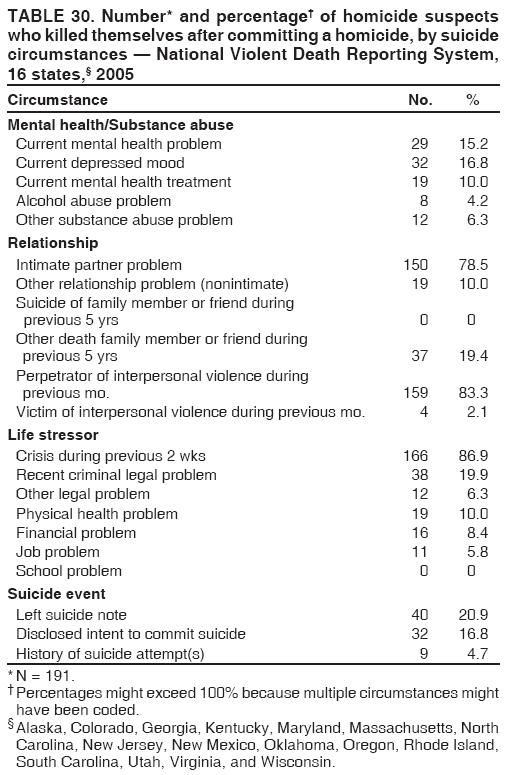 Return to top. Table 31 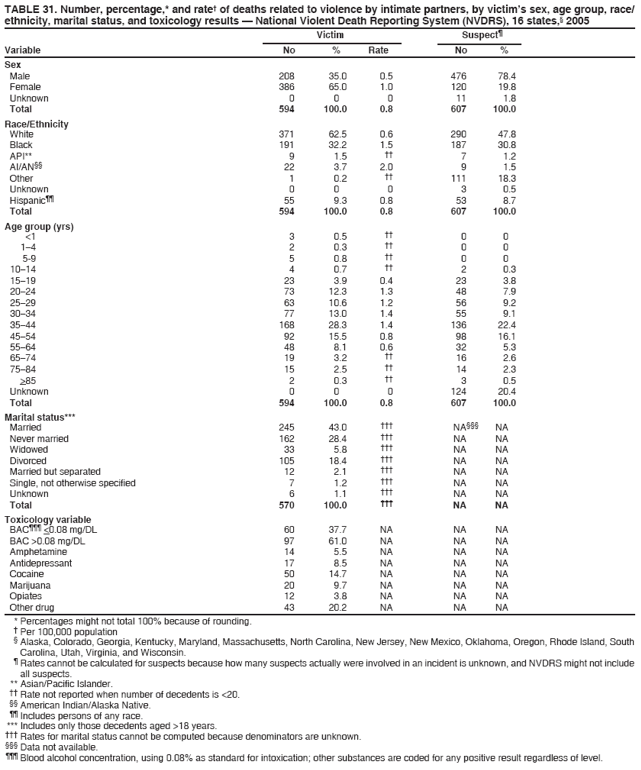 Return to top. Table 32 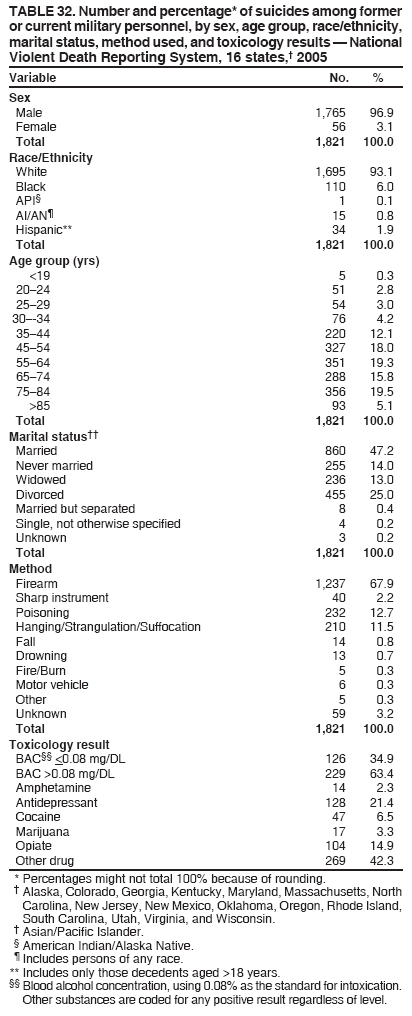 Return to top. Table 33 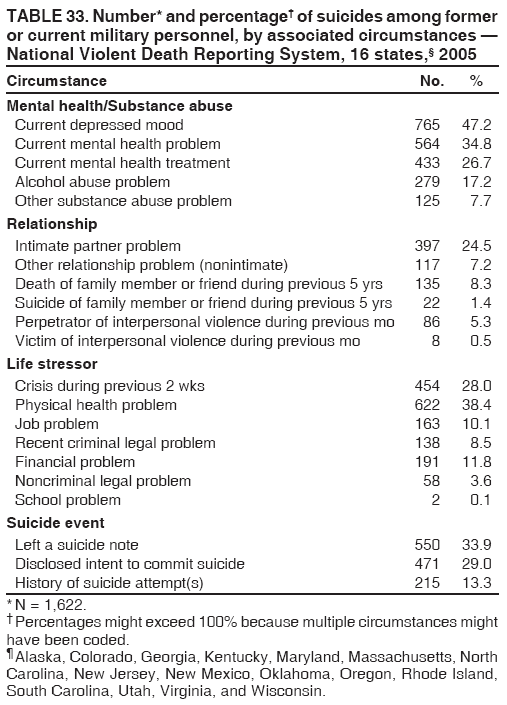 Return to top. Table 34  Return to top. Table 35 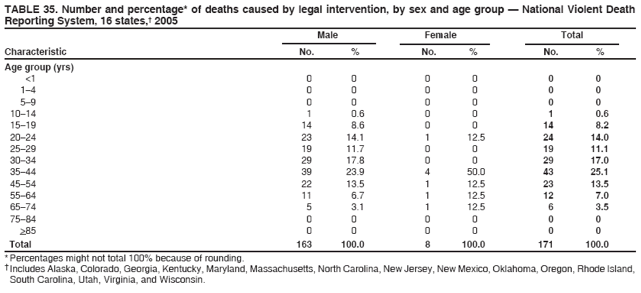 Return to top. Table 36 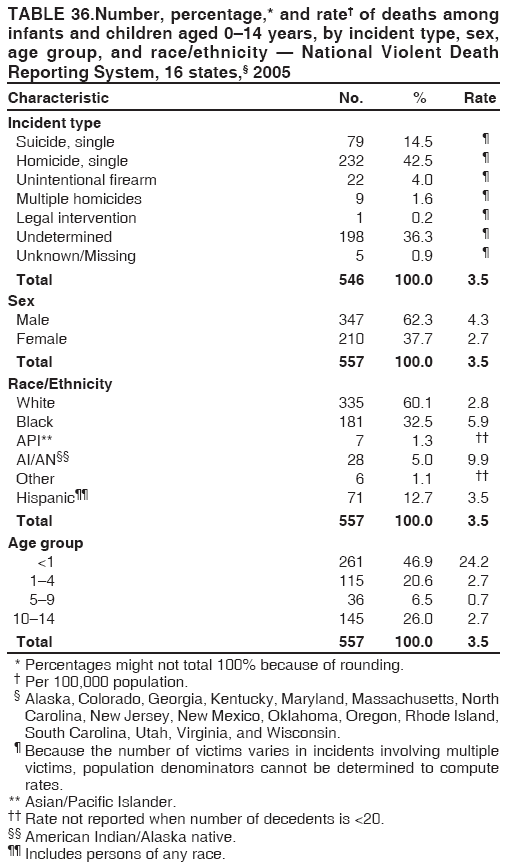 Return to top. Table 37 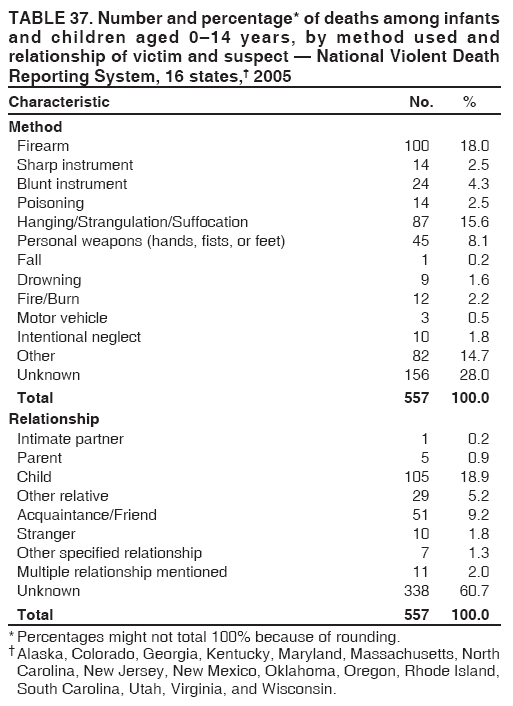 Return to top. Table 38 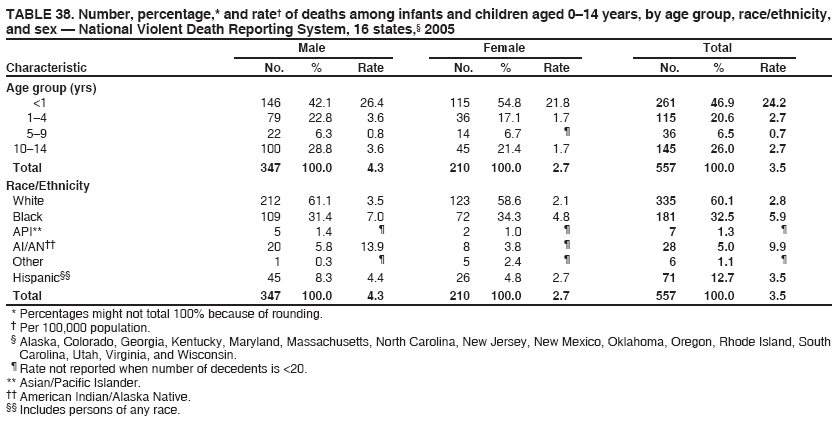 Return to top. Figure  Return to top.
Disclaimer All MMWR HTML versions of articles are electronic conversions from ASCII text into HTML. This conversion may have resulted in character translation or format errors in the HTML version. Users should not rely on this HTML document, but are referred to the electronic PDF version and/or the original MMWR paper copy for the official text, figures, and tables. An original paper copy of this issue can be obtained from the Superintendent of Documents, U.S. Government Printing Office (GPO), Washington, DC 20402-9371; telephone: (202) 512-1800. Contact GPO for current prices. **Questions or messages regarding errors in formatting should be addressed to mmwrq@cdc.gov.Date last reviewed: 3/13/2008 |
|||||||||
|